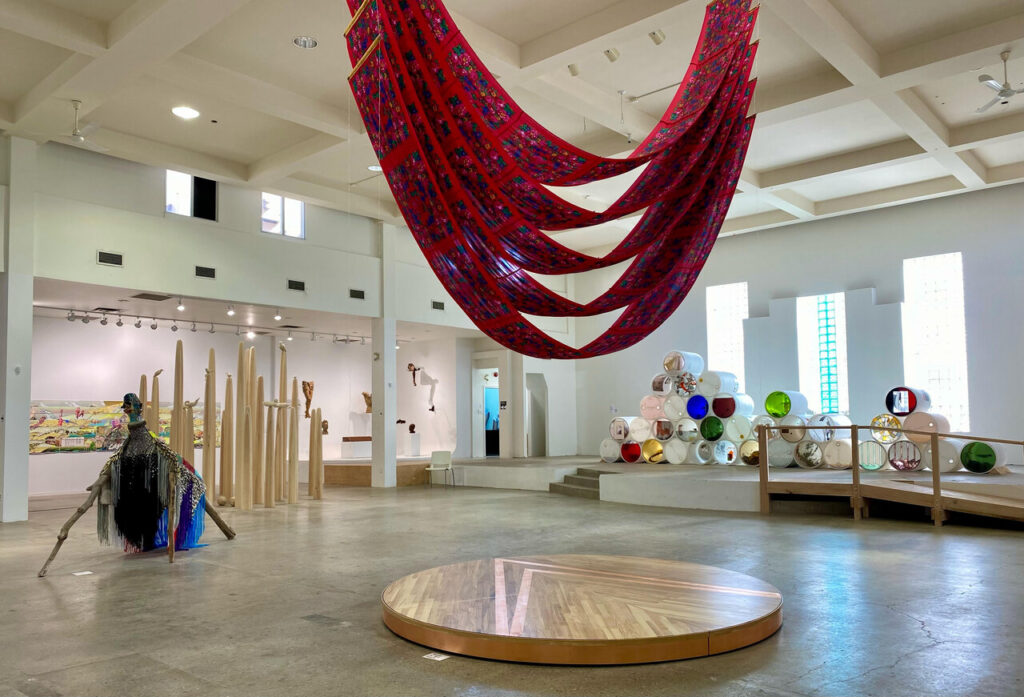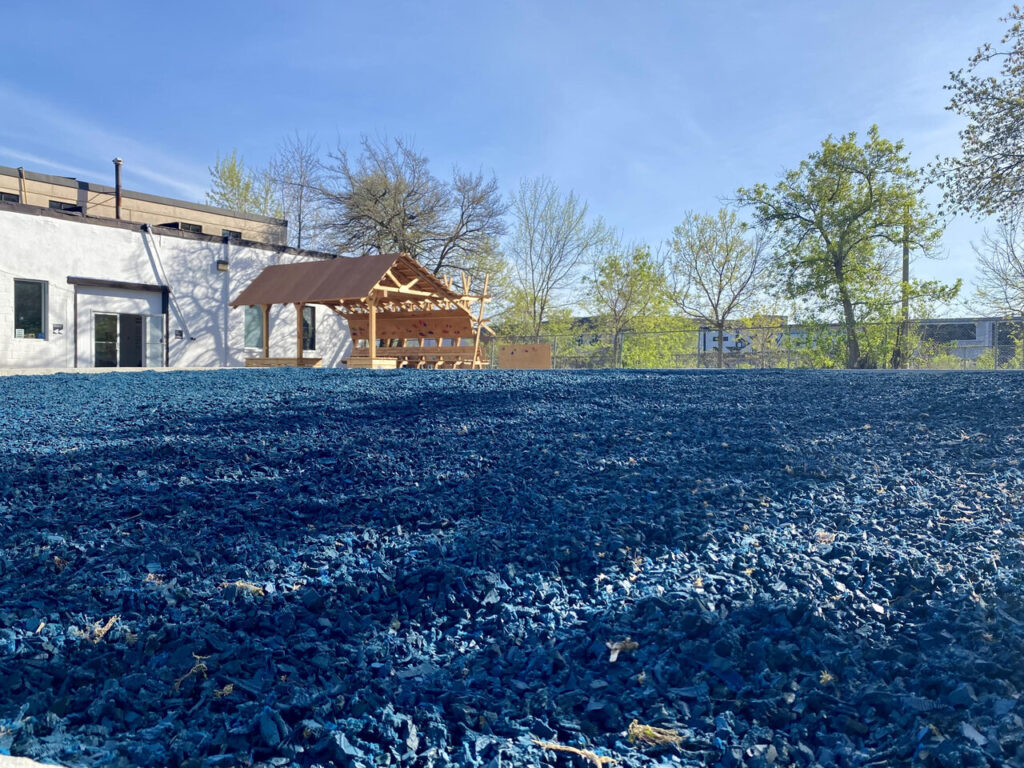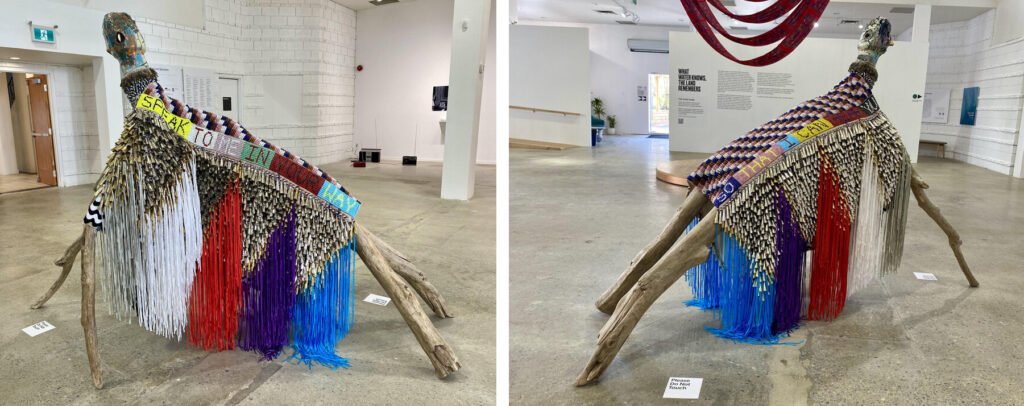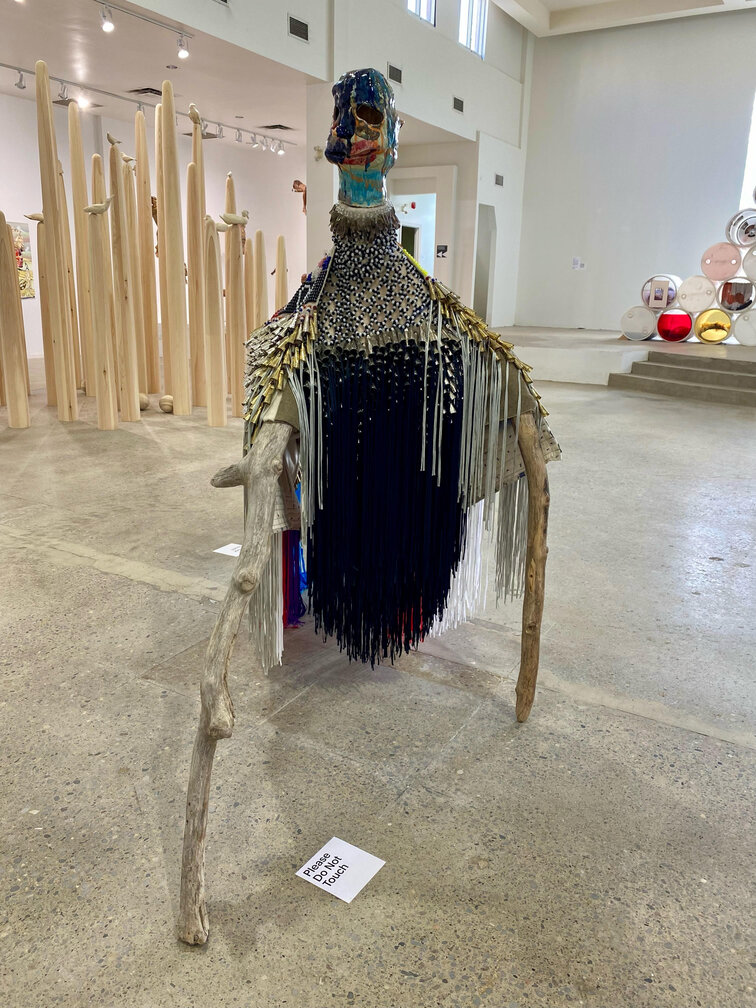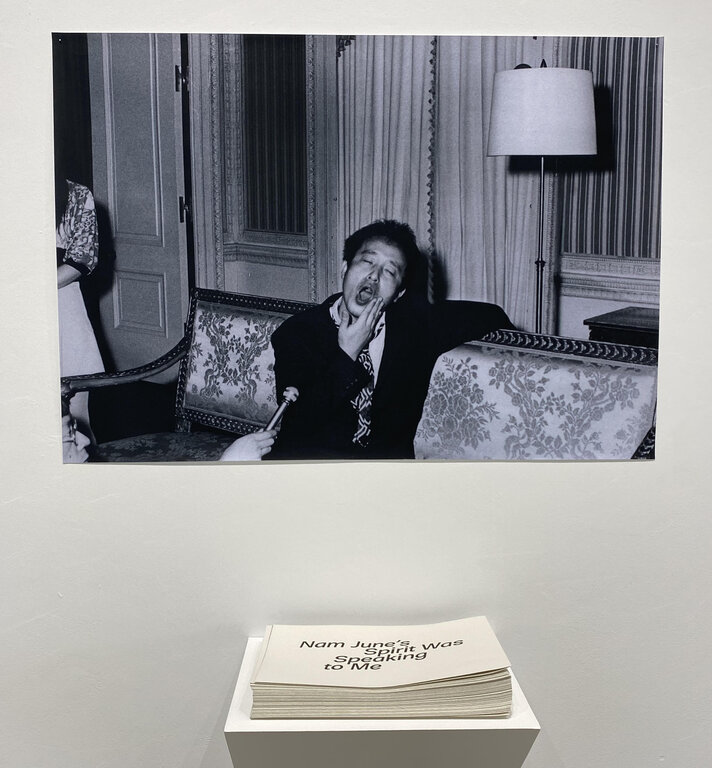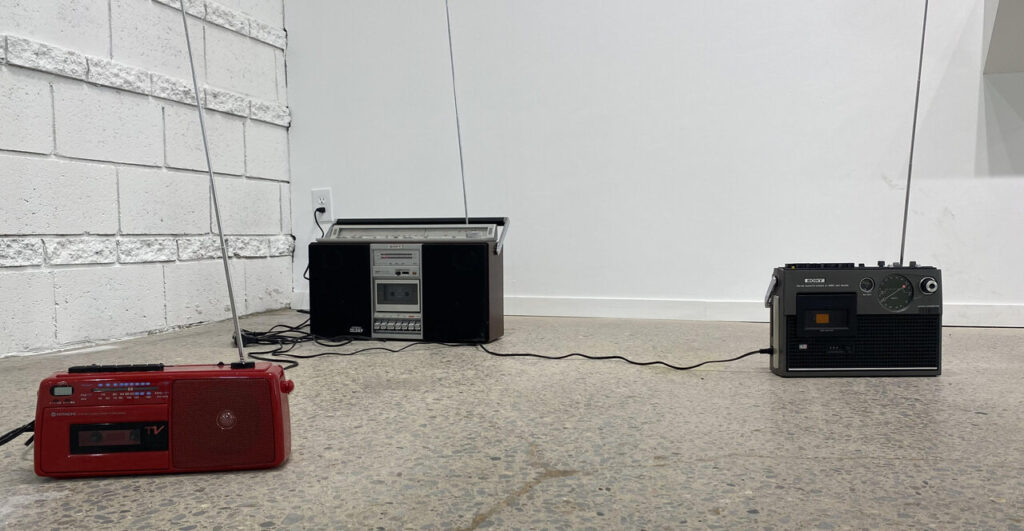The 2022 Toronto Biennial of Art exhibit at 72 Perth Avenue immerses visitors in visually engaging and interactive artworks, from the moment they approach the gallery. The exhibit features work by nine artists which reflect the Biennial’s curatorial vision: What Water Knows, the Land Remembers. In line with this vision, many of the works in the exhibit engage with histories and narratives, and explore the concept of water and land as an archive. The pieces also encourage visitors to contemplate inheritance and our relationships to the land.
Installation views of the 2nd Toronto Biennial of Art, 2022 exhibit at 72 Perth Avenue
One of the most remarkable aspects of the exhibit at 72 Perth Avenue is the way the pieces engage all the senses. In the main room of the gallery, the bright open space and high ceilings provide a peaceful setting to view colourful works in a wide variety of mediums. Several large sculptural installations occupy the floor, while video and sound installations are arranged along the walls and in smaller rooms. Visitors can hear the crackling and radio static of Aki Onda’s audio works, while the earthy scent of wood wafts over the guests as they approach Andrea Carlson’s installation of wood posts. Visitors are even invited to touch and interact with certain pieces such as Ghazaleh Avarzamani’s pool of blue mulch, located in the former parking lot of the building.
The first piece we encounter when approaching the gallery is multidisciplinary artist Ghazaleh Avarzamani’s outdoor installation Forced Afloat. The eye-catching installation features a shallow pool of vibrant blue mulch encircled by a white curb. The piece immediately establishes the immersive nature of the exhibit by encouraging visitors to interact with the installation. There is a nearby sign encouraging everyone to use the area “without prescription.” Additionally, the rubber mulch invites play by recalling a children’s playground. Yet, the interactive nature of the installation reveals tensions in how people are willing to engage with artworks, which seems to reflect Avarzamani’s interest in human games that mirror systems of power. While observing Forced Afloat from the nearby pavilion, I witnessed many people leaning over the curb to examine the blue mulch, yet no one took the plunge and stepped over the curb. The piece seems to explore how the public conceptualizes artworks and reveals the public reluctance to touch and interact with artworks, even when invited to do so.
Ghazaleh Avarzamani, Forced Afloat, 2022, blue rubber mulch, dimensions variable
Forced Afloat also introduces many of the themes that flow through the exhibit, including the concept of water as an archive. In many ways, the colour and materiality of the installation recall a pool of water. The surface of the blue mulch forms subtle peaks and valleys that evoke waves on a body of water. In the late afternoon, long tree shadows stretch across the mulch which emphasize these waves on the surface of the pool. Additionally, through the interactive nature of the piece, the installation itself becomes an archive. As humans, animals, and natural elements interact with the piece, the very form of it changes to record the history of these interactions. Mulch is displaced and replaced in different positions, new peaks and valleys are formed. Pieces of the blue mulch litter the surrounding grey gravel—evidence of these interactions.
Ghazaleh Avarzamani, Forced Afloat, 2022, blue rubber mulch, dimensions variable
Similar themes of history and archives are explored in Choctaw-Cherokee artist Jeffrey Gibson’s sculptural work SPEAK TO ME IN YOUR WAY SO I CAN HEAR YOU. Balancing on four slender legs of driftwood, with a protruding neck and ceramic head, the sculpture forms an ambiguous animal, draped in an elaborate garment. From a distance, the mixed media sculpture is a playful burst of colour and texture. However, moving closer to the sculpture reveals the intricate ways Gibson has layered different materials. The garment features colourful beading which proclaims the piece’s title in capital letters, while metal jingles and colourful fringe fall in a diagonal pattern on either side of the garment.
Looking at the artwork at a close distance also reveals its imposing presence. While the sculpture seems precariously balanced on its legs, its large size gives it a sense of strength and freedom. While examining the artwork I felt a tension between the form of the sculpture and its stasis. I imagined the animal running on its long driftwood legs, the fringe of the garment billowing behind it.
Jeffrey Gibson, SPEAK TO ME IN YOUR WAY SO I CAN HEAR YOU, 2015, driftwood, hardware, wool, canvas, glass beads, artificial sinew, metal jingles, nylon fringe, acrylic, high fire glazed ceramic
Additionally, the sculpture’s ceramic head resembles the Native American tradition of Mississippian head pots. Head pots—associated with the 13th-16th centuries—were vessels molded into the form of a human head, with facial features and an opening at the top. The ceramic head of Gibson’s sculpture seems to reference this tradition, while incorporating modern elements. Contrasting the smooth surfaces and refined facial features of historic head pots, the ceramic head of Gibson’s sculpture takes an irregular form with crude facial features. A simple line and peak suggest a mouth and nose. Two voids form large hollow eyes which give the face an eerie appearance.
Even Gibson’s use of driftwood evokes the concept of water as an archive. Over time, water smoothed and molded the driftwood into its current form, so it acts as a physical archive of its history.
Jeffrey Gibson, SPEAK TO ME IN YOUR WAY SO I CAN HEAR YOU, 2015, driftwood, hardware, wool, canvas, glass beads, artificial sinew, metal jingles, nylon fringe, acrylic, high fire glazed ceramic
Throughout the gallery, visitors are immersed in the soft static and occasional voices emanating from Aki Onda’s multimedia installation Nam June’s Spirit Was Speaking to Me. The installation is comprised of photos of the late Korean American artist Nam June Paik, radios, audio recordings, and a series of radio broadcasts. Known as the “Father of Video Art,” Nam June became well known for his innovative use of technology as a medium—specifically his use of video, television, and radio. Onda’s work continues this tradition, using the medium of radio to explore concepts of histories, archives, and inheritance.
This project was inspired by an experience Onda had in 2010 after visiting the Nam June Paik Art Centre in South Korea. While switching stations on a handheld radio, Onda stumbled upon communications from Nam June’s spirit. The audio element of the project features recordings Onda took while channelling Nam June’s spirit through the radio in different cities over the course of several years.
By compiling these recordings, Onda has created an archive of his interactions with Nam June’s spirit. The project also explores the concept of inheritance by engaging the public in the tradition. People can interact with the project by bringing their own radios to 72 Perth Avenue and attempting to pick up the radio frequencies covering the gallery. This provides an immersive way for visitors to get a sense of what Onda experienced when channelling Nam June’s spirit. Through the frequencies, the public inherits the tradition that Onda inherited from Nam June.
Aki Onda, Nam June’s Spirit Was Speaking to Me, 2017/2022, audio recordings, radio broadcast, photography, text publication, dimensions variable
The physical and audio elements of Onda’s project can not be missed. In two opposite corners of the gallery, old radios have been arranged on the floor at different angles. Onda’s audio recordings play from each corner, but can be heard throughout the gallery—ambient sound that sets a peaceful tone through the exhibit. While listening to the audio recordings, I found that the constant soft static and rhythmic beating created a relaxing, surreal atmosphere in the gallery. Every so often I was jarred from my lull by static screeches or by the sounds of faint music and voices. I found that the combination of static and jumbled voices truly captured Onda’s process of channeling Nam June’s spirit—the long process of scanning through radio stations searching, followed by the jarring excitement of picking up communications.
The Toronto Biennial of Art, 2022 exhibit at 72 Perth Avenue provides a peaceful setting for visitors to explore and interact with innovative artworks that engage all the senses. Featuring a broad range of artists, subjects, and mediums, people of all ages and demographics are sure to find pieces that captivate them. While the exhibit encourages everyone to contemplate histories, archives, and inheritance as abstract concepts, each piece also prompts us to consider our own relationships to history, as well as the traditions and land we have inherited.
Text and photo: Jennifer Boothby
*Exhibition information: What Water Knows, the Land Remembers / Toronto Biennial of Art at 72 Perth Avenue. Participating artists include: Aki Onda, Andrea Carlson, Anne Zanele Mutema, Ghazaleh Avarzamani, Jeffrey Gibson, Nadia Belerique, Paul Pfeiffer, Shezad Dawood, Tanya Lukin Linklater, March 26 – June 5, 2022, 72 Perth Avenue, Toronto. Gallery hours: Tue – Thu & Sun – Sat 10am – 6 pm, Fri 10am – 8pm.

